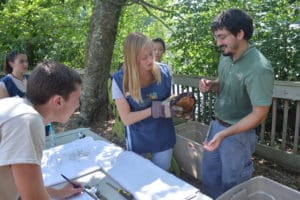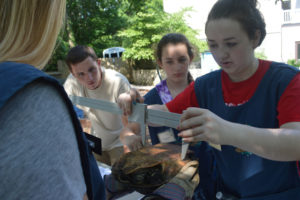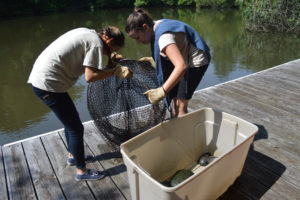Turtle Census
The Virginia Living Museum Education and Herpetology staff began a multi-year research project to monitor the population changes of freshwater turtles in a local watershed over time. The goals were to see what percentage of these turtles were native and non-native and to provide an educational platform for students, volunteers and guests to learn about native turtles and what happens when people release pets into the wild.


Use the buttons below to sign up. In 2024 the dates are:
On these days, we gather all of the turtles that we collected in these nets, and do the following:
- Identify the species of turtle and whether it’s male or female.
- Clean the shell to remove any stuck-on algae.
- Determine whether this is a new turtle or a recapture.


- Take measurements of its size and record any physical injuries or any other noteworthy observations.
- Using our numbering system, we mark the edges of the shell by making notches that correspond to the turtle’s ID. The marking process is completely painless, much like filing a fingernail.
If turtle is a recapture:
- Determine the ID Number.
- Take new measurements of its size to monitor growth rate.
- Make notes of any new injuries or other observations.
- Refresh any marks that may have faded over time.
- Release the turtle back into the lake.
Data
Males vs. Females Caught to Date
Female (64%)
Male (36%)
Native Species vs Non-native Species Caught to Date
Non-native Species (52%)
Native Species (48%)
Different Species Collected
Red-eared Slider (39%)
Northern Red-bellied Cooter(13%)
Eastern Painted Turtle(26%)
Slider Intergrade(13%)
Yellow-bellied Slider(2%)
Musk Turtle (6%)
Mud Turtle(1%)
“Slider Intergrade” is actually a hybridization of the native Yellow Belly Slider (Trachemys scripta scripta) and the non-native Red-Eared Slider (Trachemys scripta elegans).
What we have observed from our data to date
- We have caught more Red-Eared Sliders than other turtles.
- Of the turtles we have caught, there have been more non-native turtles than all other native turtle species combined.
- For whatever reason, we catch nearly twice as many females than males.






